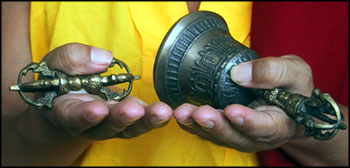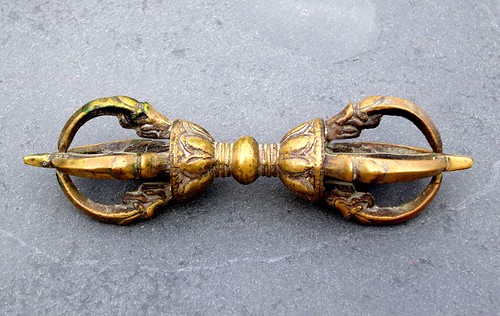The topic of the vajra arose the other day. For a long time I had considered this to be a ritual/symbolic object that just happened to have the characteristics of being an emergency kongo type weapon. The wiki article on the vajra seems to consider that the item was intended as a weapon. It quotes several myths were gods are supposed to have fought with varja. One of the translations of vajra is “thunderbolt” and gods fighting with thunderbolts is a common theme in many cultures. It is possible these myths refer to the more elemental form of thunderbolt rather than an object like the vajra. Thunderbolt itself is open to alternate interpretations. Today we assume it to be a lightning bolt but in older times the term often meant a meteorite.
Further evidence that the vajra might have been intended as a weapon lies in one of its alternate names:- kongou or kongo. If the martial aspect of the vajra is well known, certain pieces of Buddhist and Asian art that feature it begin to take on a different light. Is there an implied threat and strength in a piece, rather like the King holding a sceptre or a Pharaoh his whip?
I decided to have a quick look at how practical the vajra is as a weapon. As it happens, I happen to have one sitting on top of my computer router. I was walking through town one day and passed a music shop. They had a vajra in their window. It had come in a shipment of Tibetan instruments and they were using it for window dressing, with no idea what it was. I brought it for half of what I was willing to pay, so everyone was happy.
The central shaft of the varja is quite narrow and it can be used for certain kubotan-type locks and Eda koppo techniques. The hourglass like shape of the central portion means that for some techniques such as thumb locks there is less likelihood of the attacked part slipping free.
The vajra/kongo is primarily a striking weapon, however. The dumbbell like shape provides a very secure grip. The mouldings and shapes on the narrow central shaft also improve grip. Each end of the Vajra ends in a narrow blunt square section point. This is a far smaller striking area than I put on my homemade kongos or can be found on many commercial kubotans. An alternate translation for vajra is “diamond crusher” and it is obvious this item could put a lot of force into a very small area. I have no doubt that many attacks with a vajra could disable, injure or kill.
Next time you seen an image of a seemingly tranquil Buddhist priest with a vajra, be aware he is in fact ready with a weapon far more effective than a knuckleduster!
If you have enjoyed this article or it has been helpful to you please feel free to show your appreciation. Thank you.The Books





